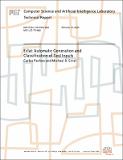Eclat: Automatic Generation and Classification of Test Inputs
Author(s)
Pacheo, Carlos; Ernst, Michael D.
DownloadMIT-CSAIL-TR-2004-063.ps (16212Kb)
Additional downloads
Other Contributors
Program Analysis
Metadata
Show full item recordAbstract
This paper describes a technique that helps a test engineerselect, from a large set of randomly generated testinputs, a small subset likely to reveal faults in the softwareunder test. The technique takes a program or software component,plus a set of normal executions—say, from an existingtest suite, or from observations of the software runningproperly. The technique works by extracting an operationalmodel of the software’s operation, and comparingeach input’s operational pattern of execution against themodel. Test inputs whose operational pattern is suggestiveof a fault are further reduced by selecting only one inputper such pattern. The result is a small portion of the originalinputs, deemed most likely to reveal faults. Thus, ourtechnique can also be seen as an error-detection technique.We have implemented these ideas in the Eclat tool, designedfor unit testing of Java classes. Eclat generates alarge number of inputs and uses our technique to select onlya few of them as fault-revealing. The inputs that it selectsare an order of magnitude more likely to reveal faults thannon-selected inputs.
Date issued
2004-10-14Other identifiers
MIT-CSAIL-TR-2004-063
MIT-LCS-TR-968
Series/Report no.
Massachusetts Institute of Technology Computer Science and Artificial Intelligence Laboratory